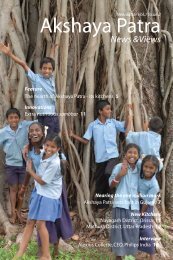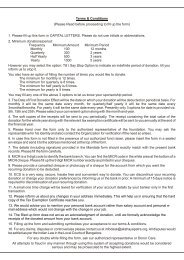The Top 100 NGOs 2013. - Akshaya Patra
The Top 100 NGOs 2013. - Akshaya Patra
The Top 100 NGOs 2013. - Akshaya Patra
You also want an ePaper? Increase the reach of your titles
YUMPU automatically turns print PDFs into web optimized ePapers that Google loves.
An Eye<br />
On <strong>The</strong> Sector.<br />
© ziyoDa kurBanova For <strong>The</strong> gloBal Journal<br />
What is your interest in <strong>NGOs</strong>?<br />
I have worked with civil society for the last 15 years. In<br />
the past I collaborated with the Avina Foundation in<br />
Latin America in the field of social entrepreneurship, and<br />
supported the Schwab Foundation while at the World<br />
Economic Forum. Today, I am the co-founder of a leading<br />
boutique philanthropy consultancy. We advise a range of<br />
clients in fulfilling their philanthropic aspirations. I am also<br />
Vice President of Sustainable Finance Geneva and a board<br />
member of several foundations. Many paths lead me to <strong>NGOs</strong><br />
as you can see.<br />
What do you see as the biggest trend in the sector over<br />
the last 1-2 years?<br />
<strong>The</strong>re are more long-term underlying trends that remain key,<br />
such as accountability and related issues of transparency.<br />
However, another interesting trend is the fact that social<br />
innovations in transition countries – or so-called ‘poor’<br />
countries – have begun to be replicated in developed<br />
economies. Let me give two examples. One of your <strong>Top</strong> <strong>100</strong><br />
<strong>NGOs</strong> of last year, Friends International, has been asked to<br />
test a model – developed originally in South East Asia –<br />
sPecial FeaTure<br />
sPecial FeaTure<br />
<strong>The</strong> gloBal Journal + January & FeBruary 2013<br />
eTienne eichenBerger<br />
execuTive DirecTor, wise PhilanThroPy aDvisers<br />
in the United States. <strong>The</strong>ir approach to working with<br />
disadvantaged youth is seen as standard-setting.<br />
Another example is the ‘Fight for Peace’ model<br />
developed in Brazil being exported to prisons in<br />
the United Kingdom.<br />
Have you observed any challenges for <strong>NGOs</strong> linked to<br />
the financial crisis?<br />
<strong>NGOs</strong> have grown more professional due to numerous<br />
factors, though the influence of limited financial resources<br />
is certainly one key element. This has been caused by the<br />
diminished performance of foundations, and the financial<br />
constraints imposed on public funding. At the same time,<br />
the financial crisis has also brought new ideas and talent<br />
into the sector. In a certain way, the crisis has provided an<br />
opportunity to rethink our status quo.<br />
What is the most innovative NGO you have<br />
worked with?<br />
I often think we fool ourselves by equating social innovation<br />
with technical innovation. At the last European Venture<br />
Philanthropy Association meeting in Dublin, a speaker<br />
suggested “social innovation is not what is new, but what<br />
works better.” I like this quote because it helps us to move<br />
beyond the paradigm that only new is better. I think,<br />
however, that Arc en-Ciel in Lebanon is a very innovative<br />
model in its context – it is very interesting to see how an<br />
organization can create great value in a tense environment.<br />
Arc-en-Ciel began operations after the civil war with<br />
wheel chairs, but today pursues six development streams,<br />
including medical waste management and eco-agriculture.<br />
Its founders have seen a weak state as an opportunity to<br />
create social value.<br />
What do you think is the NGO model of the future?<br />
<strong>NGOs</strong>, like businesses, are all about diversity – from<br />
small and medium size enterprises to global corporations.<br />
<strong>The</strong>ir respective challenges are hardly the same, and<br />
neither are their models. Future models will depend on<br />
numerous factors, driven by an NGO’s mission. For instance,<br />
an advocacy NGO will need to further strengthen its<br />
independence, an NGO focused on service delivery will<br />
need to continue to innovate with regard to generating<br />
revenues. But both small and large <strong>NGOs</strong> will need to be<br />
more accountable in terms of impact and the quality of<br />
their delivery. <strong>The</strong> time when <strong>NGOs</strong> had a blank check to<br />
“do the right thing” is gone.<br />
© cassiDy rush<br />
33 34 35<br />
an alTernaTive Bank For <strong>The</strong> rural Poor eraDicaTing PrevenTaBle BlinDness creaTive anD susTainaBle waTer soluTions<br />
Fonkoze Helen Keller<br />
NEW NEW 18<br />
When asked why he created<br />
a microfinance institution<br />
focused on women, the<br />
founder of Fonkoze, Father Joseph<br />
Philippe, was clear: “women are the<br />
backbone of the Haitian economy and<br />
the doorway into the family unit.”<br />
<strong>The</strong> largest organization of its kind in<br />
Haiti, serving more than 56,000 women<br />
borrowers – most of whom live and work<br />
in the countryside – and over 250,000<br />
savers, Fonkoze is committed to offering<br />
its clients a range of services that not<br />
only recognize the different points at<br />
which individuals can start their climb<br />
out of poverty, but also acknowledges<br />
that progress is not always linear. Much<br />
more than a bank, the organization also<br />
delivers critical programs in education,<br />
health, insurance and client protection.<br />
International<br />
For much of the 20th century,<br />
the name Helen Keller was<br />
synonymous with courage in the<br />
face of overwhelming odds. Left blind<br />
and deaf as a baby, she went on not only<br />
to become a leading advocate for the<br />
blind, but also to found Helen Keller<br />
International in 1915 as a premier<br />
organization dedicated to preventing<br />
blindness and reducing malnutrition.<br />
Today, Helen Keller International’s<br />
cost-effective and sustainable programs<br />
span 22 countries, focusing on basic<br />
eye care, vision correction, vitamin<br />
supplementation, food fortification,<br />
infant and young child feeding and<br />
community malnutrition surveillance.<br />
Committed to productive partnerships,<br />
the organization is also active in<br />
conducting and sharing research<br />
through a vibrant network of leading<br />
international institutions.<br />
<strong>The</strong>gloBalJournal.neT<br />
64<br />
65<br />
© Trevor snaPP © waTer For PeoPle<br />
Water for People<br />
hQ locaTion: haiTi hQ locaTion: uniTeD sTaTes hQ locaTion: uniTeD sTaTes<br />
Every day, nearly 6,000 people<br />
die from water-related illnesses,<br />
the vast majority children<br />
lacking access to safe drinking water<br />
and adequate sanitation facilities.<br />
Recognizing that part of the problem<br />
is the prevalence of good-hearted but<br />
unsustainable interventions, Water For<br />
People has developed an innovative<br />
model based on close collaboration<br />
with local communities and full<br />
coverage across entire districts and<br />
regions, rather than ad hoc projects at<br />
the household and village level. Local<br />
groups must be willing to not only<br />
contribute in-kind labor and funding to<br />
an entire project, but also participate in<br />
planning, implementation, operations,<br />
maintenance and repair. Across<br />
ten countries, Water For People is<br />
transforming the lives of over 300,000<br />
people – for the long-term.





